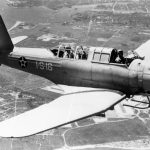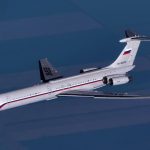We got this email in our inbox the other day, purporting to tell the story of the Boeing B-17 Flying Fortress, “All American.” The story, accompanied with some incredible pictures, told of the plane, mortally wounded, getting her crew home safely. We were pretty sure we had seen this email, sent from a friend (who got it from a friend, who got it from a friend, ad infinitum) before at some time in the past, but reading it over, some things about the chain email just didn’t make sense, so we decided to do some research.
We’ve decided to reproduce the email, as it’s certainly compelling prose, however it’s fiction.
——————————————
B-17 “All American”
(414th Squadron, 97BG) Crew:
Pilot- Ken Bragg Jr.
Copilot- G. Boyd Jr.
Navigator- Harry C. Nuessle
Bombardier- Ralph Burbridge
Engineer- Joe C. James
Radio Operator- Paul A. Galloway
Ball Turret Gunner- Elton Conda
Waist Gunner- Michael Zuk
Tail Gunner- Sam T. Sarpolus
Ground Crew Chief- Hank Hyland
B-17 in 1943
A mid-air collision on February 1, 1943, between a B-17 and a German fighter over the Tunis dock area, became the subject of one of the most famous photographs of WWII. An enemy fighter attacking a 97th Bomb Group formation went out of control, probably with a wounded pilot then continued its crashing descent into the rear of the fuselage of a Flying Fortress named “All American”, piloted by Lt. Kendrick R. Bragg, of the 414th Bomb Squadron. When it struck, the fighter broke apart, but left some pieces in the B-17. The left horizontal stabilizer of the Fortress and left elevator were completely torn away. The two right engines were out and one on the left had a serious oil pump leak. The vertical fin and the rudder had been damaged, the fuselage had been cut almost completely through, connected only at two small parts of the frame and the radios, electrical and oxygen systems were damaged. There was also a hole in the top that was over 16 feet long and 4feet wide at its widest and the split in the fuselage went all the way to the top gunner’s turret.
Although the tail actually bounced and swayed in the wind and twisted when the plane turned and all the control cables were severed, except one single elevator cable still worked, and the aircraft still miraculously flew! The tail gunner was trapped because there was no floor connecting the tail to the rest of the plane. The waist and tail gunners used parts of the German fighter and their own parachute harnesses in an attempt to keep the tail from ripping off and the two sides of the fuselage from splitting apart. While the crew was trying to keep the bomber from coming apart, the pilot continued on his bomb run and released his bombs over the target.

The turn back toward England had to be very slow to keep the tail from twisting off. They actually covered almost 70 miles to make the turn home. The bomber was so badly damaged that it was losing altitude and speed and was soon alone in the sky. For a brief time, two more Me-109 German fighters attacked the All American. Despite the extensive damage, all of the machine gunners were able to respond to these attacks and soon drove off the fighters. The two waist gunners stood up with their heads sticking out through the hole in the top of the fuselage to aim and fire their machine guns. The tail gunner had to shoot in short bursts because the recoil was actually causing the plane to turn.

Two and a half hours after being hit, the aircraft made its final turn to line up with the runway while it was still over 40 miles away. It descended into an emergency landing and a normal roll-out on its landing gear. When the ambulance pulled alongside, it was waved off because not a single member of the crew had been injured. No one could believe that the aircraft could still fly in such a condition. The Fortress sat placidly until the crew all exited through the door in the fuselage and the tail gunner had climbed down a ladder, at which time the entire rear section of the aircraft collapsed. This old bird had done its job and brought the crew home and all in one piece.
I love these old war stories especially the ones with a happy ending!
Maybe pass this on to someone who will also appreciate this amazing story.
——————————————————–
Well it is an amazing story, that much is certain. Though in reading it, the damage pictured didn’t seem to align with the damage described, a bombing mission to Tunis in northern Africa, dispatched from England is an impossibility (not to mention having to overfly the entirety of Axis-occupied Europe to do it), and the plane appears to be on the ground in a desert, which to the best of our knowledge, England is most decidedly not. There are several other problems within the story both large and small, but to completely dissect it would take forever and it would time away from the REAL story of the “All American.”

One of the fighters went straight for the nose of the lead bomber of the formation and the other came for the nose of “All American.” The crew of “All American” fired at the plane coming for them from their nose turret while firing at the fighter heading for the lead bomber from the right side nose gun. Between the fire of All American and the lead bomber, the fighter going after that plane was disabled and sent down, smoke pouring from it as it descended. The fighter that was attacking the “All American,” head-on and guns blazing, began a roll to pull away, but halfway through the maneuver, gunfire from either “All American” or the lead bomber must have killed or incapacitated the fighter pilot and the plane never completed the collision-avoiding maneuver.



There is an excellent article with an interview with Ralph Burbridge, the bombardier on “All American” in which you can read his first person account of this mission, as well as his other wartime experiences, though the article incorrectly introduces a bit of misinformation of its own.* Sadly, Burbridge passed away earlier this year at the age of 93.
*The Harold Adamson and Jimmy McHugh song “Comin’ in on a Wing and a Prayer” was not written about “All American.” The hit song, released in 1943, recounted the amazing survival of another 97th Bomb Group B-17, “Thunderbird.” The plane had been given up as lost on a January 12, 1943 mission to Tripoli but her pilot, Lieutenant John Cronkhite managed to get her back to Biskra though thoroughly shot up, with both starboard engines out and fuel tanks nearly dry. He landed with no brakes and ground-looped the plane when he ran out of runway, but that’s a story for another day.

























